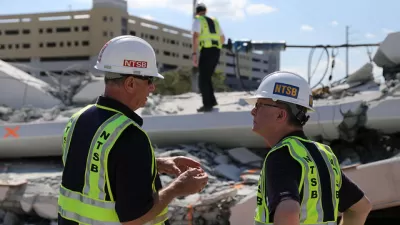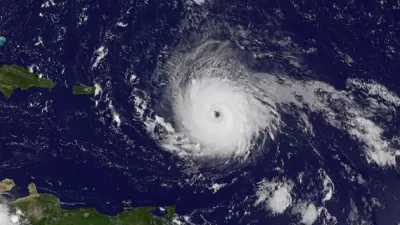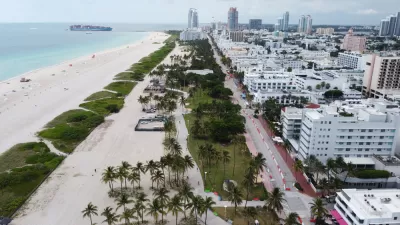A span built to remove the danger of crossing a busy eight-lane roadway to Florida International University became the danger itself when it collapsed five days after being dropped into place using innovative bridge-building techniques.
At least six are dead and no more survivors are expected to be found just days after crews had dropped an elevated 950-ton span in place [see photo] on a signature project that was intended to give Florida International University students a safe route across Tamiami Trail (Southwest Eighth Street) to the small suburban city of Sweetwater, where the university estimates 4,000 of its students live, reports the Miami Herald on March 16.
“We know that there are people missing,” said Miami-Dade Police Director Juan Perez, who did not clarify whether the death toll includes those still trapped under the bridge."
The fatalities appear to be motorists trapped in their vehicles, crushed by the 950-ton collapsing steel and concrete span, and at least one construction worker unable to escape.
The 174-foot structure was built alongside the road using accelerated bridge construction techniques while support towers were built at both ends of the crossing. It was dropped into place using cranes on March 10 – "instant bridge," as the Herald described it.
"Until it’s fully secured, a quick-build structure is unstable and requires the utmost precision as construction continues," reported the Herald on Thursday.
Properly shoring up the bridge can take weeks, a period during which even small mistakes can compound and cause a partial or total collapse, said Amjad Aref, a researcher at University at Buffalo's Institute of Bridge Engineering.
"Funding for the $14.2 million bridge, connecting plazas and walkways is part of a $19.4 million Transportation Investment Generating Economic Recovery (TIGER) grant from the U.S. Department of Transportation," noted the FIU press release [pdf] of March 10.
The FIU-Sweetwater UniversityCity Bridge is the largest pedestrian bridge moved via Self-Propelled Modular Transportation in U.S. history
"Speaking at a press conference on Friday, National Transportation Safety Board Chairman Robert Sumwalt said the agency’s team of 15 investigators will be conducting their own probe of the collapse, independent of local authorities," notes the Herald on Friday. It may take months before NTSB can determine the cause of the fatal bridge collapse.
“We are here to determine the cause and make a recommendation to make sure something like this doesn’t happen in the future,” he said.
FIU had selected a design-build team composed of MCM Construction and Figg Bridge Group. The role of the stress test, and whether traffic should have been halted during the process, will be investigated.
An image of the what the finished project would look like is here. The bridge project was the attraction "for building a cluster of apartment towers that cater to FIU students, all to be linked to campus by the new pedestrian bridge," reported the Herald on March 10.
FULL STORY: Death toll from FIU bridge collapse up to 6 as crews work to clear the rubble

Planetizen Federal Action Tracker
A weekly monitor of how Trump’s orders and actions are impacting planners and planning in America.

Maui's Vacation Rental Debate Turns Ugly
Verbal attacks, misinformation campaigns and fistfights plague a high-stakes debate to convert thousands of vacation rentals into long-term housing.

Restaurant Patios Were a Pandemic Win — Why Were They so Hard to Keep?
Social distancing requirements and changes in travel patterns prompted cities to pilot new uses for street and sidewalk space. Then it got complicated.

In California Battle of Housing vs. Environment, Housing Just Won
A new state law significantly limits the power of CEQA, an environmental review law that served as a powerful tool for blocking new development.

Boulder Eliminates Parking Minimums Citywide
Officials estimate the cost of building a single underground parking space at up to $100,000.

Orange County, Florida Adopts Largest US “Sprawl Repair” Code
The ‘Orange Code’ seeks to rectify decades of sprawl-inducing, car-oriented development.
Urban Design for Planners 1: Software Tools
This six-course series explores essential urban design concepts using open source software and equips planners with the tools they need to participate fully in the urban design process.
Planning for Universal Design
Learn the tools for implementing Universal Design in planning regulations.
Heyer Gruel & Associates PA
JM Goldson LLC
Custer County Colorado
City of Camden Redevelopment Agency
City of Astoria
Transportation Research & Education Center (TREC) at Portland State University
Jefferson Parish Government
Camden Redevelopment Agency
City of Claremont





























